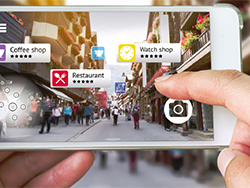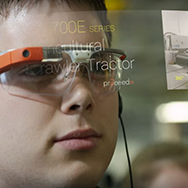 With its futuristic headsets, virtual reality may have all the razzle-dazzle, but augmented reality could turn out to have far more applications in the real world
With its futuristic headsets, virtual reality may have all the razzle-dazzle, but augmented reality could turn out to have far more applications in the real world
Humans have always struggled to accept reality. Whether we choose to escape via entertainment, self-medicate with a pint or three, or just prefer to disappear into a book, there’s an incredible strength to our yearning for something beyond the mundanity of daily lives.
The explosion of digital technology over the past few decades has enjoyed a close – some might say exploitative – relationship with our desire to escape via entertainment. In doing so, it’s given us new ways to access games, video and people who were previously located far beyond our merely analogue real-life networks.
Augmented reality (AR) is one more step on the journey to an enhanced reality. As a technology, it’s being touted for uses in sectors as wide-ranging as retail, engineering and medical services, but its use within one particular game is what introduced the technology to most of us.
“Augmented reality has been used in apps for years, but we hadn’t seen mainstream adoption until Pokemon Go,” says Mike Fawkner-Corbett, Head of Product at Sure.
The AR trick pulled by Pokemon Go was the placing of digital characters in a real-world environment using smartphones as the interface. It’s this combination of the digital and the real that characterises AR.
“Augmented reality is the layering of digital content onto the real world,” explains Max Dawes, Partnerships and Marketing Director at UK-based AR company Zappar. “The content could be in the form of a video playing on a page of a magazine or a three-dimensional model that seems to sit on the page and can be manipulated and interacted with.”
While Pokemon Go may have proven to be something of a fad – the number of players plummeted within 12 months of release – that shouldn’t detract from the sophistication of the technology that made it possible.
“In technical terms, there are several ways to create an augmented reality experience,” says Jane Todavchych, Business Development Manager at Ukrainian AR developer ThinkMobiles. “Marker-based examples of AR are the most common, requiring a camera for image recognition. When you point it at a marker – for instance, a printed image, code or a real person – it triggers the digital AR elements.
“Alternatively, markerless AR could be location-based (GPS data and phone sensors), projection-based (movement-sensitive light projections) or mapping technology, known as SLAM.”
The fact that AR maps digital elements onto real-world images is the key difference between it and virtual reality (VR), which creates a immersive digital environment around the user, who wears a headset to access and interact with the virtual world.
The fact that interaction with AR is primarily via mobile devices makes it far more accessible to consumers, and a vastly different commercial proposition to VR. But that doesn’t mean it isn’t being pushed towards the more immersive virtual experience.
Mixed reality
“There’s a middle ground between VR and AR, called mixed reality,” says Andy Delaney, Senior Consultant at C5 Alliance. “AR overlays digital information without having any awareness of the outside world, but mixed reality senses the environment and lets you interact with the physical world through digital interaction.”
Apple, which has actively promoted the development of AR applications by launching a developer tool called ARKit, has clearly decided that mixed reality is the future. It’s equipped the new iPhone X with the technology it needs to deliver a mixed reality experience.
“Apple has introduced a number of sensors onto the iPhone X to give it an awareness of the world around it,” explains Delaney.
This awareness of the surrounding environment is already being used by companies – most famously Ikea, which is using it to create a new online shopping environment. As Delaney explains: “The Ikea AR lets you see the chosen furniture within the room you want to put it in, and lets you ‘walk’ around it.”
In the world of consumer brands, AR isn’t only about selling, it’s about finding ways to get people to engage with the brand. And with attention spans in freefall, that means applying AR to a wide range of ideas.
“Asda wanted to engage with their customers in ways that weren’t transactional, which led us to create Easter egg hunts and Halloween competitions,” says Zappar’s Max Dawes.
“For other clients, it’s about data capture, whilst others want to engage with people on their mobile devices. Pez wanted to sell more refill packs, so we created an application called Pez Play. We’re in year two of that and they’ve had half a million downloads of the app.”
As is the case with modern technology, it’s consumer applications that are garnering most of the headlines and, indeed, are driving the AR field forward. However, AR’s deployment will eventually reach far beyond tracking down interesting ways to encourage customers to interact with brands.
“Augmented reality can take time-, location- and business-sensitive data and present it to operatives such as medics or engineers in the field, as and when they need it,” says Mike Fawkner-Corbett. “The military have long been users [think pilots’ heads-up displays], but in other areas AR could effectively simplify the level of skill needed to do a job.
“Businesses can use it to drive efficiencies or improve quality – and manufacturing, medical and engineering firms will benefit from it hugely,” says Fawkner-Corbett.
To some, the ultimate use of AR is to gather distant people together for meetings. However, while it’s possible to do this using virtual reality headsets, the Hollywood dream of holographic images of people sitting around the boardroom table is still that – just a dream.
In reality
But while living holograms are still in the distant future, the use of virtual screens, Minority Report-style, is closer to reality. “Within a three- to five-year period, I can see people wearing headsets that give them access to screens they can interact with,” says Delaney. “Manufacturers know that the biggest impact they can have on the workplace is to enable people to define their own workplace.”
And it’s at work that we may soon see the resurrection of a technology we all thought had passed with little more impact than a fidget-spinner. “Google has relaunched Google Glass as an enterprise edition,” says Delaney. “They recognise it has a strong use case in certain sectors.”
Whether it’s on our mobile phones, via headsets or with the latest rendering of Google Glass (see below), AR is edging into our world. While some of us already use it, it won’t be long before the rest of us are viewing our favourite tourist hotspots through the lens of additional digital information, or choosing our furniture without having to worry whether it actually goes with the wallpaper.
Google Glass is Back!
 When Google Glass was in its heyday back in 2013/14, plenty of people feared it wouldn’t be long before we were all wandering around speaking to our hi-tech specs rather than to each other.
When Google Glass was in its heyday back in 2013/14, plenty of people feared it wouldn’t be long before we were all wandering around speaking to our hi-tech specs rather than to each other.
Fast forward a couple of years and Google was announcing the end of Google Glass, much to the relief of commentators, whose fears of impending social Armageddon had been narrowly avoided. Now, just a few years after its withdrawal, Google Glass is back, only this time it’s been redeployed as a business tool rather than a consumer must-have.
As a workplace tool, Glass is able to deliver information to skilled workers precisely at the point in time they need it. Paradoxically, the very fact that workers will no longer need to learn how to do the job in advance suggests that their skills may diminish over time – but that’s an argument for another day.
Today, GE Aviation, a subsidiary of industrial giant GE, is using Glass in its Cincinnati plant to deliver instructions to workers on the assembly line. Rather than having to learn giant manuals of information or stopping regularly to check how to deal with an issue, the instructions are delivered to the worker within their line of sight as they look at the problem facing them.
GE’s research has shown that production efficiency has improved by between eight and 12 per cent as a result of no longer having to stop work to check the next step. Similarly, agricultural machinery manufacturer AGCO has reported a 25 per cent fall in production time and a 30 per cent reduction in inspection times as a direct result of staff using Google Glass.